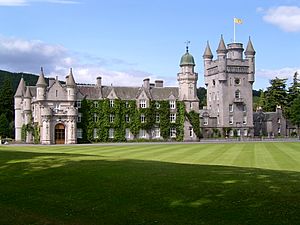Scottish castles facts for kids
Scottish castles are special buildings that combine strong defenses with comfortable homes. They first appeared in Scotland in the 1100s, when a new way of owning land, called feudalism, was introduced.
At first, many castles were made of wood and built on big mounds of earth called motte-and-baileys. But over time, many of these were replaced with strong stone castles that had tall outer walls. During the Wars of Scottish Independence, a famous Scottish king named Robert the Bruce decided to destroy many castles. He did this so the English couldn't use them if they captured them.
Later, new castles were built. Some were very large, like "livery and maintenance" castles, which could house many soldiers. When gunpowder weapons arrived, castles changed again. They got special openings for guns and stronger walls to protect against cannonballs.
Many castles built in the border areas were tower houses. These were smaller, like pele towers, or even simpler bastle houses. From the 1400s, kings started building grander "castle-style palaces" like Linlithgow Palace. Later, elements of these old castles were used in new, fancy homes called Scots baronial estate houses. These houses looked like castles but were mostly built for comfort.
In the 1600s and 1700s, castles became less important for war. Instead, they started to become popular places for tourists to visit. The Scots Baronial style became popular again in the late 1700s, especially after Balmoral Castle was rebuilt in the 1800s and became a holiday home for Queen Victoria. Today, many old tower houses have been fixed up. Many castles are now looked after by groups like the National Trust for Scotland or Historic Scotland and are open for everyone to explore.
Contents
Castles in the Middle Ages
Castles, which were fortified homes for lords or nobles, came to Scotland as kings started to gain more power in the 1100s. Before the 1120s, there weren't many castles in Scotland. The northern parts were still ruled by the kings of Norway.
David I of Scotland, who ruled from 1124 to 1153, spent time in England. He learned about castles there and wanted to bring them to Scotland. He invited Norman and French nobles to settle in Scotland. These nobles used castles to control the land and help the king extend his power. Historian Lise Hull says that castles in Scotland were more about "establishing a governing system" than about conquering land.
Most early castles were made of wood. They had a raised mound called a motte, with a wooden tower on top. Next to it was a larger fenced area called a bailey. Both were usually surrounded by a ditch (fosse) and a wooden fence (palisade), connected by a wooden bridge. Some were very big, like the Bass of Inverurie, while others were smaller.
In England, many wooden castles were rebuilt in stone during the 1100s. In Scotland, most castles that stayed in use became stone "enceinte" castles from the 1200s. These had tall, strong outer walls with battlements (notches for defense). Builders often used a traditional Scottish method of dry-stone rubble, which was then covered with a special plaster called harl to make it waterproof and look smooth.
Besides castles owned by nobles, there were also royal castles. These were often bigger and served as defenses, places for the king's court to stay, and local government centers. By 1200, there were royal castles at Ayr and Berwick.
Alexander II of Scotland (ruled 1198–1249) and Alexander III of Scotland (ruled 1241–1286) built many new castles in the modern style. But Alexander III's early death led to conflict in Scotland. In 1296, Edward I of England invaded, starting the Wars of Scottish Independence. This stopped new castle building and began a time of many castle sieges.
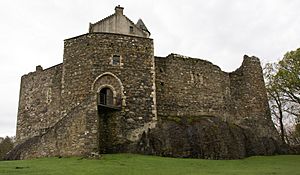
The first recorded castle siege in Scotland was in 1230 at Rothesay Castle. Norwegian attackers used axes to break down the stone walls in just three days. When Edward I invaded Scotland, he brought powerful siege equipment. Major castles fell quickly. Edinburgh Castle fell in three days, and others like Roxburgh and Stirling also surrendered.
Later English sieges, like those at Bothwell and Stirling, used huge siege machines and many workers. Because of this, Robert the Bruce (ruled 1306–1329) decided to destroy castles rather than let the English easily capture and hold them. This was called "slighting". He started with his own castles at Ayr and Dumfries, and also destroyed Roxburgh and Edinburgh.
After the Wars of Independence, new castles began to be built. Some were much larger, like "livery and maintenance" castles, which were built to house soldiers. Examples include Tantallon and Doune.
Early gunpowder weapons arrived in Scotland by the 1330s. By the 1380s, this new technology was being used in Scottish castles, starting with Edinburgh. In the 1400s, gunpowder completely changed how castles were designed. Old castles were updated with "keyhole" gun ports and platforms for cannons. Walls were made stronger to resist cannon fire.
Ravenscraig, started around 1460, was probably the first castle in Britain built specifically for artillery. It had "D-shaped" towers that could better withstand cannon fire and hold cannons. It also used "letter box" gun-ports, which became common in Scotland. Scotland also adopted a new design for castle ditches called a caponier, as seen at Craignethan Castle.
Tower Houses
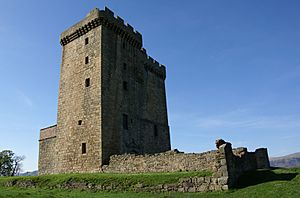
Most of the fortified homes built by nobles in the late Middle Ages were tower houses. There were about 800 of them. Smaller tower houses in southern Scotland were known as peel towers or pele houses.
Tower houses were mainly built to protect against small raiding groups, not against a large army. Historian Stuart Reid called them "defensible rather than defensive." They were usually tall, square, stone buildings with battlements on top. They often had a walled courtyard called a barmkyn or bawn. This courtyard was for keeping valuable animals safe, but it wasn't meant for serious defense.
Tower houses were built widely on both sides of the border with England from the 1300s. When James IV of Scotland took over the Lord of the Isles in 1494, many more tower houses were built in that area. Some were also built in Scottish towns.
A simpler option for small landowners and farmers was the bastle house. This was a fortified house that combined a tower house with a barmkyn. They usually had two floors. The ground floor was a byre where animals could be kept. The living area on the upper floor could only be reached by a ladder that could be removed. Most bastle houses are found within 30 kilometers (about 19 miles) of the English border and were built around the early 1500s.
Royal Renaissance Palaces
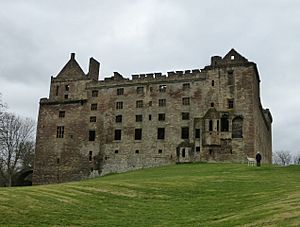
Scottish kings started building and rebuilding many royal palaces, especially under James III of Scotland (ruled 1460–1488), and even more under James IV of Scotland. This reached its peak under James V of Scotland (ruled 1513–1542). They used special money, like money from taking over important lands, to show their power across the kingdom. They did this by making existing castles grander and changing them. These changes show the influence of Renaissance styles.
Linlithgow Palace was first built under James I of Scotland. It was called a palace from 1429, which was probably the first time this word was used for a building in Scotland. James III expanded it, making it look like a fashionable Italian palace with four sides and corner towers. It combined classic balance with knightly images and used harl to give it a clean, Italian look.
Italian builders worked for James IV, during whose reign Linlithgow was finished. Other palaces were rebuilt with Italian-style proportions. According to historian John Dunbar, these were the "earliest examples of coherent Renaissance design in Britain."
The change in building style showed new political friendships. James V became close with France during his rule. He saw French Renaissance buildings when he visited for his marriage to Madeleine of Valois in 1536. His second marriage to Mary of Guise might have led to even more French influences.
Buildings from James V's reign mostly ignored the style popular in England under Henry VIII. Instead, they adopted styles that were clearly European. This started with the big changes at Linlithgow. Then came rebuilding at Holyrood, Falkland, Stirling, and Edinburgh. Roger Maison called these "some of the finest examples of Renaissance architecture in Britain."
Much of this castle rebuilding was planned and paid for by James Hamilton of Finnart (around 1495–1540). He also worked on Blackness Castle and Rothesay Castle. Scottish architecture didn't just copy European styles. It mixed them with traditional local patterns, adapting them to Scottish ways and materials, especially stone and harl. Similar ideas can be seen in the private homes of nobles, like Mar's Wark in Stirling (around 1570) and Crichton Castle (1580s).
Sixteenth and Seventeenth Century Castles
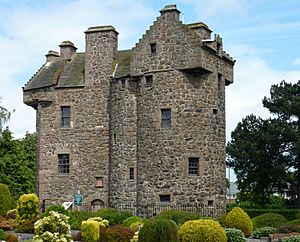
In the 1540s and 1550s, during a time of French involvement in Scotland, a series of earthwork forts and additions to existing castles were built to defend the border. These included adding single bastions (projecting parts of a fortification) at Edinburgh, Stirling, and Dunbar.
A unique style of large private homes in Scotland, later called Scots Baronial, began around the 1560s. It kept many features of the old, high-walled Medieval castles, even though gunpowder weapons had made them less useful for defense. This style might have been influenced by the French builders who came to Scotland to work on royal palaces.
It used ideas from tower houses and peel towers, like their parapets (low protective walls), corbels (supporting brackets), and bartizans (small turrets). The new estate houses built from the late 1500s by nobles and landowners were mainly for comfort, not defense, even though they were often called castles. They kept many of these outside features that had become linked with nobility, but with a larger layout. A common design was the "Z-plan," which had a rectangular main building with towers at opposite corners, like Colliston Castle (1583) and Claypotts Castle (1569–1588).
William Wallace, the king's master builder from 1617 until his death in 1631, was very important. He worked on rebuilding the collapsed North Range of Linlithgow from 1618, Winton House, and started work on Heriot's Hospital in Edinburgh. He developed a special style that mixed Scottish fortification elements with Flemish (Dutch/Belgian) influences, using a Renaissance plan similar to Château d'Ancy-le-Franc. This style can be seen in noble homes like Caerlaverlock (1620), Moray House in Edinburgh (1628), and Drumlanrig Castle (1675–1689). It was very influential until the Baronial style was replaced by grander English styles in the late 1600s, which focused on classical designs and comfortable country houses.
The Decline of Castles
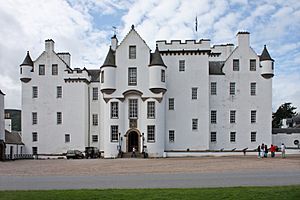
In 1603, James VI of Scotland also became King of England, bringing a time of peace between the two countries. The royal court moved to London. Because of this, building work on royal castles in Scotland mostly stopped, except for occasional visits.
Some castles continued to be used for military purposes into the 1700s. Royal castles like Edinburgh, Dumbarton, and Stirling, along with Dunstaffnage, Dunollie, Blackness, and Ruthven Castle, were still used as working forts. Tower houses were built until the 1640s. After the Restoration (when the monarchy returned), the fortified tower house went out of style. However, because Scotland's economy was weak, many smaller castles continued to be used and changed into homes, rather than being rebuilt.
During the Bishop's Wars, castles that supported the king against the Covenanters, like Caerlaverock and Threave in 1640, were "slighted". This meant their roofs were removed and walls were broken to make them unusable. Tantallon was used as a base for Scottish attacks on Oliver Cromwell's army in 1651. As a result, Cromwell's siege cannons destroyed it, and it was no longer used as a home after that.
The series of Jacobite risings from 1689 threatened the Crown in Scotland. This led to the rebellion in 1745. Stirling Castle was able to defend against the Jacobite attack in 1745. The siege of Blair Castle, at the end of the rebellion in 1746, was the last castle siege in Britain. After the conflict, castles like Corgaff were used as barracks for soldiers sent to control the Highlands. Kildrummy, Huntly, and Doune were destroyed because of their role in the rebellion.
From the late 1700s, castles became popular tourist attractions. Blair Castle was a favorite because of its beautiful gardens. Stirling Castle was popular for its romantic historical connections. Tours became more common in the 1800s, often starting in Edinburgh and then heading north by train and steamboat. Blair Castle remained popular, and other castles like Cawdor Castle joined the tour circuit once the railway reached Fort William. Scottish castle guidebooks often told long historical stories about the sites, sometimes using details from Romantic novels. Sir Walter Scott's novels set in Scotland made several northern castles famous, including Tantallon, which appeared in his poem Marmion (1808).
Gothic Revival Style
In Scotland, castles became popular again in the late 1700s and 1800s. This was part of a bigger movement called the Gothic Revival. New houses were built, and old ones were changed to look like Gothic or Scots Baronial castles.
Inveraray Castle, built from 1746 with help from William Adam, shows early use of turrets in this revived style. His son, Robert Adam, designed houses like Mellerstain and Wedderburn that used this style. But it's most clearly seen at Culzean Castle, which Adam redesigned from 1777. These were mostly traditional Palladian-style houses that added some outside features of the Scots Baronial style.
Abbotsford House, the home of Walter Scott, was very important for making this style popular in the early 1800s. Rebuilt for him from 1816, it became a model for the modern revival of the Baronial style. Common features borrowed from 1500s and 1600s houses included battlemented gateways, crow-stepped gables (stair-shaped gables), pointed turrets, and machicolations (floor openings for dropping things on attackers).
The style was popular across Scotland. Architects like William Burn (1789–1870) and David Bryce (1803–1876) used it for many homes. It was also used in cities, like for Cockburn Street in Edinburgh (from the 1850s), and for the National Wallace Monument at Stirling (1859–1869). The rebuilding of Balmoral Castle as a Baronial palace and its use as a royal retreat from 1855–1858 made the style even more popular.
Scots Baronial architects often "improved" existing castles. For example, Floors Castle was changed in 1838 by William Henry Playfair, who added grand turrets and cupolas. The style also spread to England, where architect Edward Blore added a Scots Baronial touch to his work at Windsor Castle.
Castles Today
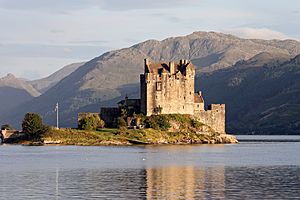
The Baronial style was most popular in the late 1800s. Building large houses became less common in the 1900s. However, it still influenced some estate houses, like Skibo Castle, which was rebuilt for industrialist Andrew Carnegie (1899–1903). Building slowed down after World War I, and changes in society reduced the need for big country houses.
A few modern "castles" have been built, combining new and old styles. Examples include Basil Spence's Broughton Place (1936) and Glenskirlie Castle (2007).
Restoring castles began in the early 1900s. Projects included fixing up Duart Castle on Mull and completely rebuilding Eilean Donan from just a few old stones. The restoration movement grew after World War II, with many people wanting to fix up tower houses. This included Oliver Hill's restoration of Inchdrewer Castle in 1965.
The restoration of tower houses and smaller castles continues today. Recent examples include Fenton Tower and Ballone Castle. Historic Scotland has started a "Scottish Castle Initiative" to encourage private investment in restoring Scotland's castles. They even have a list of castles that could be restored. Despite these efforts, some castles are still on Scotland's Buildings at Risk Register.
Most of Scotland's castles, whether they are ruins or still lived in, are privately owned. However, many are open to the public at least sometimes. In the 1900s, several older castles were given to the state. These are now looked after by Historic Scotland, an agency created in 1991. Historic Scotland cares for over 300 properties, including about 65 castles, all of which are open to the public. These include famous castles like Edinburgh and Stirling, as well as many tower houses and ruined castles.
The National Trust for Scotland (founded 1931) looks after several castles and estate houses built after the Middle Ages, such as Culzean and Craigievar, which were lived in until the 1900s. The Landmark Trust restores and rents out historic buildings as holiday homes, including Saddell Castle, Castle of Park, and Roslin Castle. Some other castles are owned by local governments, like Dudhope Castle in Dundee. Others are maintained by groups that work to preserve old buildings, like Sauchie Tower.
Images for kids
-
Caerlaverock Castle, a moated triangular castle, first built in the 1200s.



